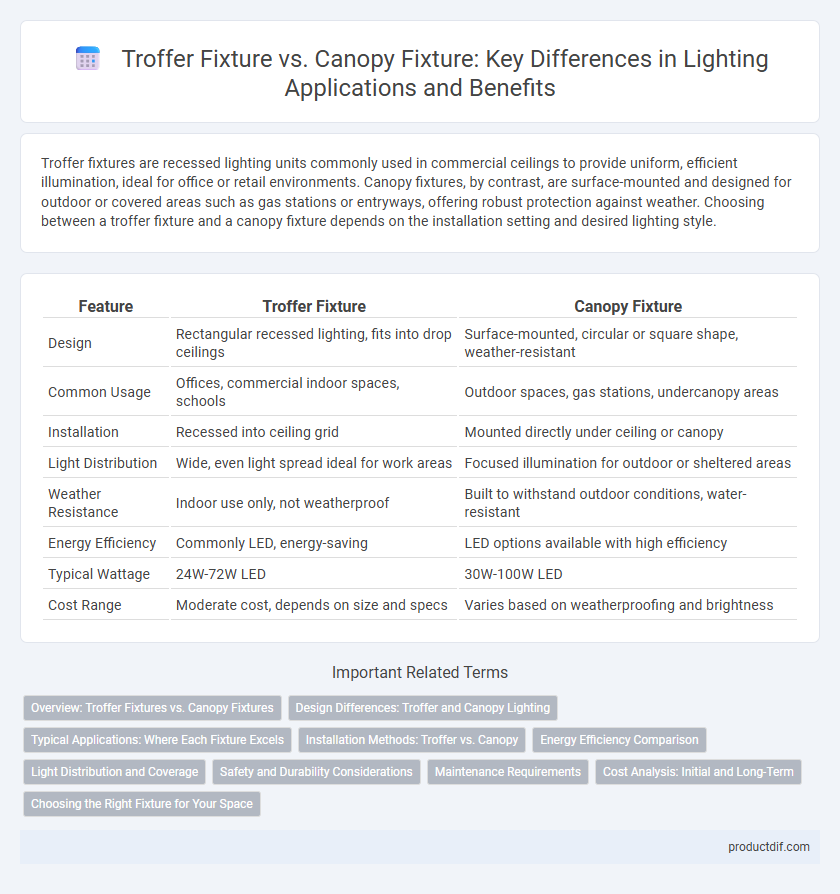Troffer fixtures are recessed lighting units commonly used in commercial ceilings to provide uniform, efficient illumination, ideal for office or retail environments. Canopy fixtures, by contrast, are surface-mounted and designed for outdoor or covered areas such as gas stations or entryways, offering robust protection against weather. Choosing between a troffer fixture and a canopy fixture depends on the installation setting and desired lighting style.
Table of Comparison
| Feature | Troffer Fixture | Canopy Fixture |
|---|---|---|
| Design | Rectangular recessed lighting, fits into drop ceilings | Surface-mounted, circular or square shape, weather-resistant |
| Common Usage | Offices, commercial indoor spaces, schools | Outdoor spaces, gas stations, undercanopy areas |
| Installation | Recessed into ceiling grid | Mounted directly under ceiling or canopy |
| Light Distribution | Wide, even light spread ideal for work areas | Focused illumination for outdoor or sheltered areas |
| Weather Resistance | Indoor use only, not weatherproof | Built to withstand outdoor conditions, water-resistant |
| Energy Efficiency | Commonly LED, energy-saving | LED options available with high efficiency |
| Typical Wattage | 24W-72W LED | 30W-100W LED |
| Cost Range | Moderate cost, depends on size and specs | Varies based on weatherproofing and brightness |
Overview: Troffer Fixtures vs. Canopy Fixtures
Troffer fixtures are recessed lighting units typically designed for ceiling grids in commercial spaces, providing uniform, widespread illumination ideal for offices and retail environments. Canopy fixtures, in contrast, are surface-mounted lighting solutions often used in outdoor or semi-outdoor areas such as entryways, parking garages, and gas stations, offering durable, weather-resistant illumination with focused light distribution. Choosing between troffer and canopy fixtures depends on installation environment, lighting needs, and fixture compatibility with architectural elements.
Design Differences: Troffer and Canopy Lighting
Troffer fixtures feature a recessed rectangular design primarily used in drop ceilings, providing uniform and diffused lighting suitable for offices and commercial spaces. Canopy fixtures have a surface-mounted, often circular or square shape designed for outdoor or semi-outdoor locations, such as building entrances and gas stations, emphasizing durability and weather resistance. The design differences between troffer and canopy lighting focus on installation method, shape, and intended environment, influencing fixture selection based on architectural and functional requirements.
Typical Applications: Where Each Fixture Excels
Troffer fixtures excel in commercial and office environments, providing uniform, recessed lighting ideal for drop ceilings and large open spaces. Canopy fixtures are typically used in outdoor or semi-outdoor locations such as gas stations, parking garages, and entryways, offering robust, weather-resistant illumination. Each fixture optimizes lighting performance based on installation demands, with troffers enhancing interior ambiance and canopies maximizing durability and brightness in exposed settings.
Installation Methods: Troffer vs. Canopy
Troffer fixtures are installed recessed into drop ceilings, making them ideal for grid ceiling systems with accessible plenum spaces, requiring precise alignment and secure mounting within the ceiling tiles. Canopy fixtures mount directly onto flat surfaces such as walls or ceilings, using brackets or mounting plates that simplify installation without needing ceiling access. The choice between troffer and canopy fixtures depends on ceiling type and installation ease, with troffers suited for suspended ceilings and canopies for exposed or hard ceilings.
Energy Efficiency Comparison
Troffer fixtures typically offer higher energy efficiency compared to canopy fixtures due to their recessed installation and compatibility with LED technology, which reduces energy consumption by up to 50%. Canopy fixtures, while durable and suited for outdoor use, generally consume more power as they often rely on higher wattage bulbs to ensure broader light distribution. Selecting troffer fixtures in commercial or office environments can lead to significant energy savings and reduced utility costs over time.
Light Distribution and Coverage
Troffer fixtures provide uniform, wide-area light distribution ideal for office or commercial ceilings, efficiently illuminating large spaces with minimal glare. Canopy fixtures concentrate light downward, offering focused coverage for exterior or entryway applications, enhancing visibility and safety in specific zones. Selecting between troffer and canopy fixtures depends on the required coverage area and desired light dispersion pattern for optimal illumination effectiveness.
Safety and Durability Considerations
Troffer fixtures, designed for recessed installation in drop ceilings, offer enhanced safety by minimizing exposed components and reducing dust accumulation, which decreases fire hazards. Canopy fixtures, often mounted on ceilings with exposed elements, require durable materials and weatherproofing to withstand outdoor conditions and prevent corrosion or electrical faults. Both fixture types must comply with safety standards such as UL certification to ensure long-term durability and reliable performance in their respective environments.
Maintenance Requirements
Troffer fixtures typically require less maintenance due to their recessed installation, which protects internal components from dust and physical damage, extending bulb and ballast lifespan. Canopy fixtures, often exposed to outdoor elements, demand more frequent cleaning and inspection to prevent corrosion and water intrusion that can degrade performance. Selecting a troffer fixture reduces maintenance costs in indoor settings, while canopy fixtures are suitable for outdoor areas despite their higher upkeep needs.
Cost Analysis: Initial and Long-Term
Troffer fixtures generally have a higher initial cost due to their complex design and integrated LED technology compared to canopy fixtures, which are simpler and more affordable upfront. However, troffer fixtures offer greater energy efficiency and longer lifespans, leading to lower maintenance and operational expenses over time. Canopy fixtures may incur additional costs related to more frequent bulb replacements and higher energy consumption, impacting long-term budget planning.
Choosing the Right Fixture for Your Space
Troffer fixtures excel in providing uniform, recessed lighting ideal for office ceilings and commercial spaces, enhancing productivity with their broad light distribution and low glare. Canopy fixtures are better suited for outdoor or non-ceiling installations, offering durable, weather-resistant illumination for parking lots, walkways, and entryways. Selecting the right fixture depends on the environment's lighting needs, ceiling type, and exposure to elements to ensure optimal performance and energy efficiency.
Troffer fixture vs canopy fixture Infographic

 productdif.com
productdif.com